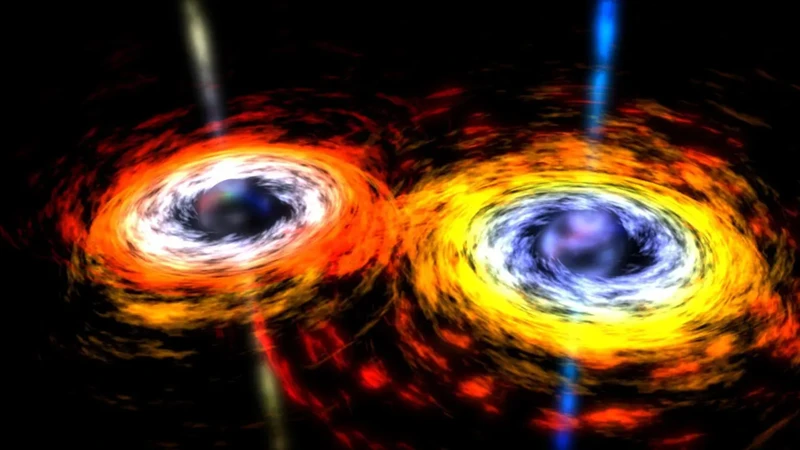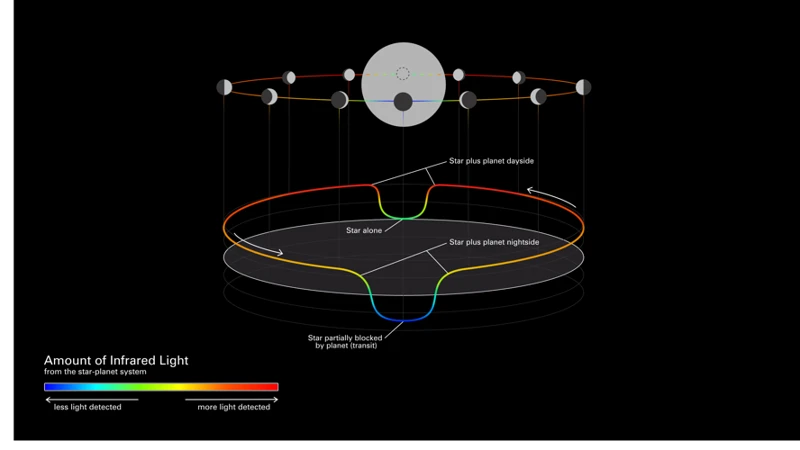Black holes: one of the most fascinating and enigmatic phenomena in the universe. These cosmic entities defy our understanding of physics and challenge the limits of our imagination. From their birth to their eventual demise, the lifespan of black holes is a captivating journey shrouded in mystery. In this article, we will embark on a cosmic adventure, exploring the formation, active phase, evolution, and final demise of these celestial objects. Join us as we unravel the secrets of black holes and delve into their captivating journey through the cosmos.
Contents
- Formation of Black Holes
- Active Phase
- Evolution and Aging
- Final Demise
- Conclusion
-
Frequently Asked Questions
- 1. How are black holes formed?
- 2. Can black holes be created on Earth?
- 3. Do black holes always lead to destruction?
- 4. Are there different sizes of black holes?
- 5. Are black holes visible?
- 6. Can anything escape the gravitational pull of a black hole?
- 7. Do all black holes have an accretion disk?
- 8. What is Hawking radiation?
- 9. Can black holes collide with each other?
- 10. Is it possible to travel through a black hole?
- References
-
Frequently Asked Questions
- 1. How are black holes formed?
- 2. What is a stellar black hole?
- 3. How are supermassive black holes different from stellar black holes?
- 4. What is the accretion process in black holes?
- 5. What are quasars and active galactic nuclei?
- 6. How does Hawking radiation contribute to the evolution of black holes?
- 7. Can black holes decay naturally?
- 8. Can black holes merge with each other?
- 9. What happens when black holes merge?
- 10. Is it possible for black holes to disintegrate into elementary particles?
- References
- Read More
Formation of Black Holes

The formation of black holes is a captivating cosmic spectacle that occurs through different mechanisms, leading to the creation of two distinct types of black holes. Firstly, stellar black holes are formed when massive stars exhaust their nuclear fuel and undergo a cataclysmic supernova explosion, causing their core to collapse under its own gravitational pull. The remaining mass, packed into an incredibly dense point called a singularity, forms a black hole. On the other hand, supermassive black holes are believed to emerge from the accretion of vast amounts of matter and the merger of smaller black holes over billions of years. The exact processes behind the formation of supermassive black holes are still a subject of ongoing investigation and scientific debate. Through these mechanisms, black holes are born, silently waiting to unleash their gravitational power upon the universe.
1. Stellar Black Holes
Stellar black holes, as their name suggests, are formed from the remnants of massive stars that undergo a supernova explosion. When a star with a mass greater than about three times that of our Sun exhausts its nuclear fuel, it collapses under its own gravity. This collapse creates an intense gravitational force, causing the star’s core to become incredibly dense, forming a singularity. The singularity is a point with virtually zero volume but infinite density, surrounded by an event horizon from which nothing, not even light, can escape. With their intense gravitational pull, stellar black holes have the power to distort the fabric of spacetime, creating an extraordinary gravitational phenomenon. The size of a stellar black hole is determined by its mass, with smaller black holes having a few times the mass of our Sun, while larger ones can be tens of times more massive. These celestial phenomena continue to enthral scientists and cosmologists, serving as gateways to further understand the mysteries of the cosmos.
2. Supermassive Black Holes
Supermassive black holes, as their name suggests, are exceptionally massive cosmic entities that reside at the centers of most galaxies, including our own Milky Way. These black holes are characterized by their immense size, with masses ranging from millions to billions of times that of our sun. The formation of supermassive black holes is an ongoing area of research, with several theories proposed to explain their origins. One hypothesis suggests that they may evolve from the accumulation of mass through mergers of smaller black holes and the continuous accretion of surrounding matter such as gas, dust, and even stars. Another theory suggests that supermassive black holes could form directly from the collapse of large gas clouds during the early stages of galaxy formation. The details of their formation and growth, however, remain elusive. Nevertheless, the presence of supermassive black holes has a profound impact on their host galaxies. Their immense gravitational pull influences the motion of surrounding stars and gas, shaping the galaxy’s structure and evolution. Additionally, supermassive black holes are believed to play a crucial role in the formation of galactic structures and the regulation of star formation rates within galaxies. The study of supermassive black holes is essential not only for understanding the lifespan of these cosmic entities but also for unraveling the mysteries of galaxy formation and evolution.
Active Phase

During the active phase of a black hole’s existence, it undergoes fascinating processes that showcase its immense power. One of the key phenomena observed is the accretion process, where surrounding matter, such as gas and dust, gets pulled towards the black hole by its gravitational force. As this matter gets closer, it forms an accretion disk around the event horizon, heating up and emitting intense radiation. The accretion process can generate tremendous amounts of energy, making black holes one of the brightest objects in the universe. In certain cases, this energy output can give birth to quasars, which are incredibly luminous active galactic nuclei powered by supermassive black holes. These celestial powerhouses can influence the growth and evolution of galaxies. Exploring the active phase of black holes reveals a dynamic and awe-inspiring side to these cosmic entities.
1. Accretion Process
The accretion process is a fundamental aspect of black hole activity during their active phase. It involves the accumulation of surrounding matter, such as gas and dust, onto the black hole’s event horizon. As these materials approach the black hole, they become trapped by its immense gravitational pull, forming a swirling disc known as an accretion disk. The friction and heat generated as the matter orbits the black hole cause the accretion disk to emit intense radiation, including X-rays and gamma-rays. This energy release is a vital characteristic of accretion, allowing astronomers to detect and study these mysterious objects. The accretion process can occur in various contexts, such as when a black hole is in a binary system with a companion star, or when material from a nearby galaxy is funneled toward a supermassive black hole at its center. Understanding the intricacies of accretion is crucial for comprehending the behavior and evolution of black holes throughout their cosmic journey. By studying the accretion phenomenon, scientists can gain insights into the mechanisms that govern the growth and activity of black holes and further unlock the secrets of the universe.
2. Quasars and Active Galactic Nuclei
Quasars and Active Galactic Nuclei (AGNs) are celestial phenomena that are closely related to black holes. Quasars are extremely luminous objects found at the centers of galaxies, emitting vast amounts of energy derived from the accretion of matter onto supermassive black holes. They are characterized by their intense brightness, often outshining entire galaxies. AGNs, on the other hand, encompass a broader class of objects that includes quasars as well as other types of active galactic nuclei. AGNs exhibit various characteristics such as jets and radio emissions, indicating the presence of a supermassive black hole at their core. These energetic phenomena occur when surrounding matter, such as gas and dust, falls toward the black hole and releases an enormous amount of energy in the process. The accretion disk surrounding the black hole reaches incredibly high temperatures, emitting radiation across the electromagnetic spectrum. The study of quasars and AGNs provides valuable insights into the behavior and properties of black holes, shedding light on their impact on galaxy formation and evolution. To learn more about the connection between celestial objects and astrology, you can explore the secrets of Ophiuchus and the significance of astrological oppositions in astrology.
Evolution and Aging

The evolution and aging of black holes are complex and intriguing processes that unfold over vast spans of time. One phenomenon that plays a significant role in the later stages of a black hole’s existence is Hawking radiation. Proposed by physicist Stephen Hawking, this theoretical concept suggests that black holes slowly emit particles and energy due to quantum effects near the event horizon, causing them to lose mass and slowly shrink over time. This process is incredibly slow, and it can take an immense amount of time for a black hole to evaporate completely. Additionally, stellar interactions can also impact a black hole’s lifespan. Interactions with nearby stars or other celestial objects can result in the exchange of mass, altering the size and properties of the black hole. These interactions can contribute to the growth or decay of a black hole, further influencing its evolution and aging. As black holes endure the eons, they continue to engage with the cosmos, transforming and evolving in ways that continue to astonish and captivate astronomers and physicists alike.
1. Hawking Radiation
The existence of Hawking radiation revolutionized our understanding of black holes. Proposed by physicist Stephen Hawking, this theoretical concept suggests that black holes are not completely devoid of radiation, but instead emit particles over time. According to the theory of quantum mechanics, virtual particle-antiparticle pairs continuously pop in and out of existence in empty space. When this phenomenon occurs near the event horizon of a black hole, one of the particles can fall into the black hole, while the other escapes into space. This process is known as Hawking radiation. Remarkably, Hawking radiation implies that black holes slowly lose mass and energy over time, eventually leading to their evaporation. However, it’s important to note that the rate of black hole evaporation is incredibly slow. For a black hole with the mass of our Sun, the evaporation process would take an astonishing 10^67 years. This mind-boggling timescale ensures that the lifespan of black holes is significantly longer than the current age of the universe. The concept of Hawking radiation not only shed light on the potential fate of black holes but also provided a connection between quantum mechanics and general relativity, two fundamental theories in physics.
2. Slow Decay of Black Holes
Black holes, despite their reputation as voracious cosmic devourers, can also experience a slow decay over time, albeit on an incredibly long timescale. This phenomenon is attributed to a quantum mechanical process known as Hawking radiation, named after physicist Stephen Hawking. According to Hawking’s theory, black holes are not completely devoid of activity. Instead, they emit particles and energy through a process of radiation. Through quantum fluctuations near the event horizon, pairs of virtual particles can pop into existence, with one particle falling into the black hole while the other escapes into space. This process gradually depletes the mass and energy of the black hole, pushing it towards a state of eventual evaporation. However, it is important to note that this decay is painstakingly slow, with the time required for a black hole to completely evaporate being far longer than the current age of the universe itself. As a result, black holes will continue to exist and exert their gravitational influence for an unimaginable duration, even as they slowly dissipate particle by particle into the vast cosmic expanse.
3. Stellar Interactions
Stellar interactions play a significant role in the evolution and aging of black holes. When two stars orbit each other closely in a binary system, they can undergo a process called mass transfer. In this scenario, material from one star is drawn towards the other due to gravitational forces. If one of the stars in the binary system is a black hole, it can accrete matter from its companion star, gradually increasing its mass. This process, known as stellar cannibalism, can have a profound impact on the black hole’s evolution. The accretion of mass leads to an increase in the black hole’s gravitational pull, making it more powerful and potentially fueling the emission of radiation and the formation of an accretion disk. Additionally, in some cases, the interaction between a black hole and its companion star can lead to the ejection of material from the binary system, creating jets of high-energy particles that shoot out into space. These jets are known as relativistic jets and are observed in certain black hole systems, such as microquasars. Stellar interactions are a dynamic and influential process that shapes the behavior and characteristics of black holes throughout their lifespan, offering a deeper understanding of these cosmic enigmas.
Final Demise

The final demise of black holes is a complex and captivating phenomenon that encompasses several potential scenarios. One possibility is the black hole evaporation proposed by physicist Stephen Hawking. According to his theory, black holes gradually lose mass over an extremely long period of time due to a quantum effect known as Hawking radiation. Another potential fate for black holes is merger with other black holes. As black holes encounter each other, they can merge, resulting in the formation of a larger black hole with an even stronger gravitational pull. Lastly, there is the intriguing possibility of disintegration into elementary particles. Some theories suggest that black holes could eventually break apart into their fundamental building blocks, releasing a burst of energy in the process. The exact mechanisms determining the final demise of black holes remain an active area of research, offering a glimpse into the mysterious and awe-inspiring nature of these cosmic entities.
1. Black Hole Evaporation
Black hole evaporation, also known as Hawking radiation, is a fascinating phenomenon predicted by physicist Stephen Hawking. According to his theory, black holes are not entirely black, but rather emit faint radiation due to quantum effects near the event horizon. The process begins with the creation of particle-antiparticle pairs spontaneously popping into existence near the black hole’s event horizon. In a normal scenario, these particles would quickly annihilate each other, disappearing back into the vacuum of space. However, when this process occurs right at the edge of a black hole, one particle can fall into the event horizon while its counterpart escapes into space. The escaping particle is perceived as radiation, known as Hawking radiation. Remarkably, this radiation causes the black hole to lose mass gradually over time. As a result, the black hole slowly evaporates, eventually dissipating into oblivion. This process is incredibly slow for stellar black holes, with a mass similar to that of the Sun, taking roughly 10^67 years to evaporate. In contrast, supermassive black holes, residing in the cores of galaxies, would take an unimaginable amount of time to evaporate completely. While the exact implications and mechanisms of black hole evaporation are still being explored, this phenomenon provides a possible glimpse into the ultimate fate of these extraordinary cosmic entities.
2. Merger with Other Black Holes
When it comes to the final demise of black holes, merger with other black holes is a fascinating phenomenon that occurs under specific conditions. Over time, black holes may encounter each other in densely populated regions of space, such as galactic centers or dense star clusters. As these black holes draw closer due to gravitational forces, their immense masses begin to interact, resulting in an intricate cosmic dance. As they spiral inward, their strong gravitational pull causes them to emit ripples in the fabric of spacetime known as gravitational waves. These waves carry energy away from the system, causing the black holes to gradually lose orbital energy and approach each other even closer. Eventually, this intimate cosmic tango culminates in a violent merger, as the two black holes collide and coalesce into a single, more massive black hole. The merger process releases an enormous amount of energy in the form of gravitational waves, creating ripples that permeate through the universe and carry information about the cataclysmic event. This phenomenon was first directly observed in 2015 by the Laser Interferometer Gravitational-Wave Observatory (LIGO), offering compelling evidence of black hole mergers and opening a new window into the study of these celestial entities. The merger with other black holes marks a pivotal moment in the lifespan of a black hole, altering its characteristics and setting the stage for further cosmic transformations.
3. Disintegration into Elementary Particles
As black holes continue to evolve and age, they face a fascinating and mysterious fate – disintegration into elementary particles. This process is a consequence of Hawking radiation, a theoretical phenomenon proposed by physicist Stephen Hawking. According to Hawking’s theory, black holes are not completely void of radiation. Instead, they emit particles and antiparticles at their event horizon, causing them to slowly lose mass and eventually evaporate. This process, known as Hawking radiation, is a result of the quantum effects that occur near the boundary of a black hole. Over an incredibly lengthy timescale, this gradual loss of mass leads to the black hole becoming smaller and smaller until it reaches a point where it completely disintegrates into elementary particles. These particles disperse into the surrounding space, contributing to cosmic particle populations and leaving behind no trace of the once formidable black hole. The process of disintegration into elementary particles provides a fascinating glimpse into the final stages of a black hole’s life cycle, marking the end of its existence in a spectacular display of cosmic dissolution.
Conclusion

In conclusion, the lifespan of black holes takes us on a remarkable journey through the vastness of space and time. These enigmatic cosmic entities, born through the collapse of massive stars or the accumulation of immense amounts of matter, hold a fascinating place in our understanding of the universe. From their formation, through their active phase where they exhibit immense gravitational power, to their evolution and aging, black holes continue to intrigue scientists and inspire our awe and curiosity. The slow decay of black holes, the potential for mergers with other black holes, and the phenomenon of Hawking radiation add further layers to their complex story. Ultimately, as black holes near their final demise, they may evaporate through Hawking radiation, disintegrate into elementary particles, or merge with other black holes. The exact fate of black holes remains an exciting area of ongoing research. As we continue to explore the secrets of black holes, we gain valuable insights into the fundamental laws of physics and our understanding of the universe at large. The journey of black holes from birth to death serves as a testament to the endless wonders and mysteries that lie beyond our earthly realm.
Frequently Asked Questions

1. How are black holes formed?
Black holes are formed through the collapse of massive stars or the accretion of vast amounts of matter, depending on the type of black hole.
2. Can black holes be created on Earth?
No, black holes cannot be created on Earth. The conditions required for the formation of a black hole, such as extreme mass and gravitational forces, are not present on our planet.
3. Do black holes always lead to destruction?
While black holes are immensely powerful and can cause destruction in their vicinity, they also play an important role in the formation of galaxies and the evolution of the universe.
4. Are there different sizes of black holes?
Yes, black holes come in various sizes. Stellar black holes can have masses a few times larger than that of our sun, while supermassive black holes can have masses billions of times greater.
5. Are black holes visible?
Black holes themselves are not visible, as they do not emit any light. However, their presence can be inferred by observing their gravitational effects on surrounding matter and light.
6. Can anything escape the gravitational pull of a black hole?
Anything that enters the event horizon of a black hole, including light, becomes trapped and cannot escape its gravitational pull.
7. Do all black holes have an accretion disk?
No, not all black holes have an accretion disk. An accretion disk is a glowing ring of hot gas and matter that forms around a black hole when it is actively feeding on surrounding material.
8. What is Hawking radiation?
Hawking radiation is a theoretical prediction made by physicist Stephen Hawking. It suggests that black holes can emit tiny particles over time and gradually lose mass, eventually evaporating completely.
9. Can black holes collide with each other?
Yes, black holes can collide and merge with each other under certain circumstances. When two black holes merge, they release a tremendous amount of energy in the form of gravitational waves.
10. Is it possible to travel through a black hole?
Currently, our understanding of physics suggests that it is highly unlikely for anything to survive the journey through a black hole. The extreme tidal forces and intense gravitational pull would likely tear apart any matter that gets too close.
References
Frequently Asked Questions

1. How are black holes formed?
Black holes are formed when massive stars undergo gravitational collapse or through the collision of galaxies.
2. What is a stellar black hole?
A stellar black hole is formed from the remnants of a massive star that has exhausted its nuclear fuel and undergone a supernova explosion.
3. How are supermassive black holes different from stellar black holes?
Supermassive black holes are much larger in size and have millions or even billions of times the mass of our Sun, while stellar black holes typically have a few times the mass of the Sun.
4. What is the accretion process in black holes?
The accretion process refers to the gradual accumulation of matter onto a black hole, which releases enormous amounts of energy in the form of radiation and jets of particles.
5. What are quasars and active galactic nuclei?
Quasars and active galactic nuclei are extremely bright and energetic sources of radiation that are powered by the accretion of matter onto supermassive black holes at the centers of galaxies.
6. How does Hawking radiation contribute to the evolution of black holes?
Hawking radiation is a theoretical prediction that suggests black holes can slowly lose mass and energy over time. This process is believed to contribute to the eventual evaporation of black holes.
7. Can black holes decay naturally?
Yes, black holes can decay naturally through the process of Hawking radiation, which occurs very slowly over an extremely long timescale.
8. Can black holes merge with each other?
Yes, black holes can merge with each other when they come into close proximity, resulting in the formation of a larger and more massive black hole.
9. What happens when black holes merge?
When black holes merge, they release a tremendous amount of energy in the form of gravitational waves, causing ripples in the fabric of spacetime.
10. Is it possible for black holes to disintegrate into elementary particles?
There is a theoretical possibility that black holes can disintegrate into elementary particles, but this process is not yet fully understood and is still a subject of ongoing scientific research.







